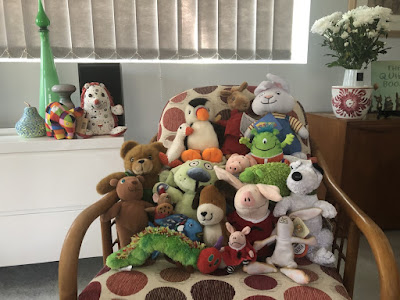“Read
stories to build empathy and make a better world.” Emily Gravett (Author)
“Even more
important than teaching our kids the actual skills of reading is to cultivate a
deep love of stories.” Sarah Mackenzie blog“A picture book is a piece of art created to be cherished and applauded. … I give you permission to simply READ ALOUD – no questions, no stopping, no after-reading conversations.” Maria Walther
Here are the contents of the handout I used at my Preschool night which was sponsored by Puffin/Penguin and Beachside Books.
Read every
day, read slowly, and
hold the book so the children can see the illustrations
Read with joy and passion – this should not be a
chore – vary your tone (soft and loud)
Practice: “the
task is more than speaking print. Knowing when to turn the page of a picture
book in order to build suspense or keep pace with the flow of the text can make
an enormous difference.”
Use voices,
movement and songs. Find books with a repeated refrain, encourage
the children to join in. Children love to fill in missing rhyming words.
Why not make a display of the book covers you share, don’t
confuse quality with quantity.
Choosing lots
of different books
to read aloud will build your preschooler's vocabulary, and help your children learn about different topics and
understand how stories are structured
and what characters do in them. Find poetry books, read nursery rhymes, match
fiction and nonfiction.
Finding books - use your public library, visit
book shops, charity book sales, fill your space with books.
Before
you begin, look at the cover, end papers, title page and say the title,
author and illustrator names. Make this part of your routine every time you
read a book to your group.
Don’t spend
too long
“explaining things”. You can always go back later and explore the words and
ideas a little more once you’ve allowed the children to ask questions.
Seize
the moment, foster curiosity. Plan to read and re-read. “Read it again” is
a huge compliment from a child.
If you want to have a discussion
(hold off
until your second reading):
Ask questions when you are reading together. For example:
• What do
you see on this page?
• How do you
think the characters feel?
• What do
you think is going to happen next?
When you have finished, talk about how your child feels
about the book:
• What did
they like?
• What
didn’t they like?
• What can
they remember about what happened?
• Who was their favourite character? Why?
• Link the
story to the children’s experiences. Can they remember when they did something
similar?
Some things to think about:
·
Don’t
read stories you don’t enjoy yourself. Your dislike will show up in your
reading and that defeats your purpose.
· Don’t
keep reading a book once it is obvious it was a poor choice. Admit the mistake
and choose another. Make sure, however, that you give the book a fair chance to
get rolling. There are some books that just start off slow and get better but
you can avoid this all together by reading the book yourself before reading it
to your children.
· Don’t
feel like you have to tie every book you read to class work.
· Don’t
overwhelm the listener. Make sure the book you read is appropriate for the
intellectual, social, and emotional level of the children you are reading to.
· Don’t
impose your interpretation of a reading onto your children. A story can be just
plain enjoyable, no reasons necessary and still give you plenty to talk about.
Don’t use the book as a threat (to get the
child(ren) to do or not to do something). As soon as your child or classes see
that you have turned the book into a weapon, they will change their attitudes
about books from positive to negative.







No comments:
Post a Comment